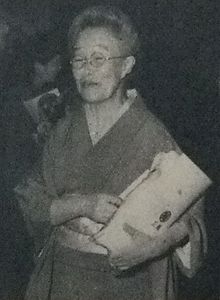Andō Kō

Andō Kō ( Japanese 安藤 幸 , real name: 幸 田 幸 , Kōda Kō ; * December 6, 1878 in the Shitaya district (today: Taitō ), in the Tokyo Prefecture ; † April 8, 1963 ) was a Japanese violinist. Her eldest brother was the writer Kōda Rohan , another older brother the explorer Gunji Shigetada (1860-1924), the youngest brother was the historian Kōda Shigetomo (1873-1954). Together with her sister Kōda Nobu , Kō is considered a pioneer of violin playing and classical western music in Japan. One of her students was Shin'ichi Suzuki , who developed the music education concept named after him, the Suzuki method .
Life
Kō started playing the violin at the age of 10. the Austrian musician Rudolf Dittrich discovered her talent and taught Kō. She continued her education at the "Tokyo Conservatory" ( 東京 音 楽 学校 , today: Tokyo University of the Arts ), which she graduated in 1898. During her studies she was friends with the nursery rhyme writer Higashi Kume (1877-1969). As the second Japanese woman after her sister Nobu, she was sent abroad to study the violin, but unlike her sister, she was sent to Germany. In 1899 she left Japan to meet Rudolf Dittrich, who had returned to Vienna. However, Kō decided to study with Joseph Joachim at the “Berlin Conservatory” (today: Berlin University of the Arts ) . In the same year she began studying with Joachim's pupil and later successor Karl Markees (1865–1926). From 1900 she was taught by Joachim himself. When she returned to Japan in 1903, she became professor of violin at the Tokyo Conservatory. In 1905 she married the Anglicist Katsuichirō Andō While Kō now continued to teach under her new family name Kō Andō in Tokyo, her husband moved to Kyoto shortly after the marriage to work there. The marriage turned into a weekend relationship with five children. One of her sons was the writer and Germanist Takagi Taku (1907–1974).
From the accusations that the press raised against her sister Nobu at the turn of the century, Kō was spared. But although she was also admitted to the Japanese Academy of Arts in 1942 , the Conservatory dismissed her informally and abruptly in 1943. After her resignation she taught violin as a private teacher until the end of her life. She was the first woman to be honored in 1958 as a person of special cultural merit .
Andō Kō died of a cerebral haemorrhage in 1963 at the age of 84.
Remarks
- ↑ Margret Mehl gives Andō Shōichirō as the name of her husband. The information is probably based on an obvious misreading of the Kanji 勝 , Onyomi: Shō , Kunyomi: katsu . Tamagawa, on the other hand, gives Katsutarō as a first name, whereby the reading ta does not match the spelling 勝 一郎 (2nd character). The reading Katsuichirō given here follows the Opac catalog of the National Parliamentary Library .
- ↑ According to Margret Mehl, the couple had six children.
Individual evidence
- ↑ 安藤 幸 . In: 朝日 日本 歴 史 人物 事 典 at kotobank.jp. Retrieved April 14, 2015 (Japanese).
- ↑ 安藤 幸 . In: 20 世紀 日本人 名 事 典 at kotobank.jp. Retrieved April 14, 2015 (Japanese).
- ↑ a b c d Yuko Tamagawa: Four female musicians. The gender structure of musical culture in modern Japan . In: Marion Gerards, Rebecca Grotjahn (eds.): Music and Emancipation. Oldenburg contributions to gender research . tape 12 . BIS-Verlag, Oldenburg 2010, ISBN 978-3-8142-2196-0 , p. 179 ( uni-oldenburg.de [PDF; accessed on April 15, 2015]).
Web links
- Margaret Mehl: Earthquakes and Pioneering Sisters in Japan. violinist.com, March 16, 2011, accessed April 13, 2015 .
- Margaret Mehl: Kôda Shimai: the Pioneering Sisters (2): Kôda Kô. violinist.com, April 1, 2011, accessed April 13, 2015 .
- Margaret Mehl: The Pioneering Kôda Sisters (3). violinist.com, May 18, 2011, accessed April 13, 2015 .
| personal data | |
|---|---|
| SURNAME | Andō, Kō |
| ALTERNATIVE NAMES | 安藤 幸 (Japanese); Kōda Kō (real name); 幸 田 幸 (real name, Japanese) |
| BRIEF DESCRIPTION | Japanese violinist |
| DATE OF BIRTH | December 6, 1878 |
| PLACE OF BIRTH | Shitaya district, today: Taitō , Tokyo Prefecture |
| DATE OF DEATH | April 8, 1963 |